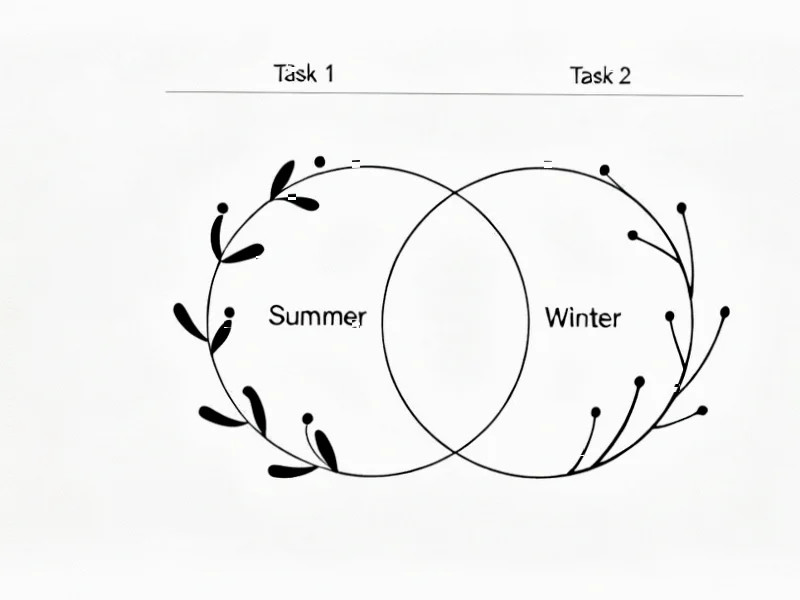According to Nature, groundbreaking research published in Nature Human Behaviour reveals that humans and artificial neural networks show nearly identical patterns of transfer and interference during continual learning. The study involved 306 human participants across discovery and replication samples, paired with twinned linear neural networks that followed identical trial schedules. Both systems learned two successive tasks involving mapping plants to locations on a ring across different seasons, with task similarity manipulated across three conditions: identical rules (Same), 30-degree shifted rules (Near), and 180-degree shifted rules (Far). The research found that both humans and networks showed highest transfer benefits in similar rule conditions but also suffered the most catastrophic interference, with Near condition networks showing complete rule overwriting while Far condition networks maintained perfect task separation through orthogonal representations. This parallel reveals fundamental constraints in how learning systems manage knowledge transfer.
Table of Contents
The Fundamental Learning Dilemma
What makes this research particularly compelling is how it exposes a universal constraint in learning systems. The trade-off between transfer and interference appears to be baked into the very nature of how knowledge representations form and interact. When we learn something new that’s similar to existing knowledge, our brains—and artificial networks—naturally try to leverage existing mental frameworks. This creates efficiency gains but comes with the risk of catastrophic interference, where new learning overwrites or corrupts previous knowledge. The study’s finding that this occurs identically in both biological and artificial systems suggests we’re dealing with a mathematical inevitability rather than a biological limitation.
What This Means for AI Development
For artificial intelligence researchers, these findings present both challenges and opportunities. The fact that even simple linear networks exhibit the same interference patterns as humans suggests that current approaches to continual learning may be fundamentally limited. Most AI systems today struggle with catastrophic forgetting—the tendency to completely lose previously learned information when trained on new tasks. This research indicates that the problem runs deeper than specific architectures or training methods. The dimensional analysis showing that networks create separate dimensional subspaces for dissimilar tasks provides crucial insight into how we might design systems that can maintain knowledge separation while still allowing beneficial transfer.
Implications for Human Learning and Education
The human implications extend far beyond artificial intelligence. Educational systems and corporate training programs could benefit enormously from understanding these interference dynamics. The research suggests that when teaching sequential concepts, educators need to be strategic about similarity spacing. Teaching highly similar concepts back-to-back might maximize initial learning efficiency but could cause significant interference and forgetting of earlier material. The bimodal distribution in human responses—where some learners in the Near condition avoided interference while others showed complete rule overwriting—points to individual differences in learning strategies that could inform personalized education approaches.
The Representation Problem in Machine Learning
What’s particularly telling is how the networks managed dissimilar tasks by creating orthogonal representations—essentially carving out separate mental “spaces” for each task. This mirrors how humans might compartmentalize knowledge about different domains. The finding that networks used the same subspace for similar tasks but created new, perpendicular spaces for dissimilar ones provides a mathematical explanation for why some knowledge transfers easily while other knowledge remains isolated. This has profound implications for how we design AI systems that need to learn multiple related skills without interference.
Future Research and Practical Applications
The most immediate application of this research lies in developing better continual learning algorithms for AI. Understanding that the interference problem stems from representational overlap rather than just network capacity could lead to new architectures that actively manage subspace separation. For human learning, we might develop interventions that help learners create better mental separations between similar concepts. The research also raises questions about whether we can train both humans and AI to be more strategic about when to leverage existing knowledge versus when to create new mental frameworks—essentially learning how to learn more effectively.
Broader Implications for AI Safety
These findings have significant implications for AI safety and alignment. If artificial systems exhibit the same fundamental learning constraints as humans, we might be able to better predict and manage how AI systems will generalize knowledge and handle novel situations. The fact that both systems show this trade-off suggests it’s a fundamental property of learning rather than a bug to be eliminated. This could inform how we design AI systems that need to operate in dynamic environments while maintaining stable knowledge bases—a critical requirement for safe, reliable artificial intelligence.



